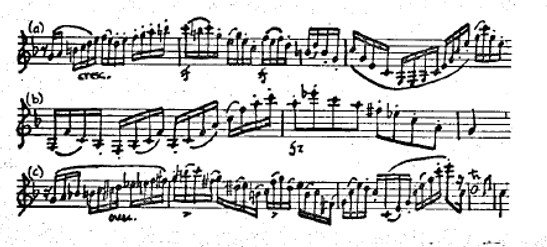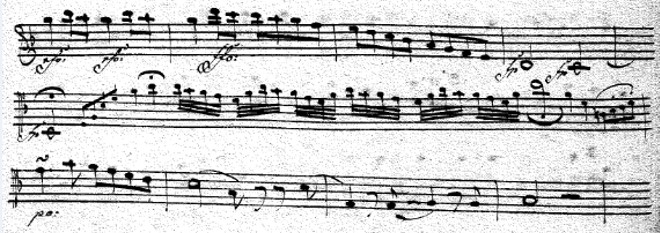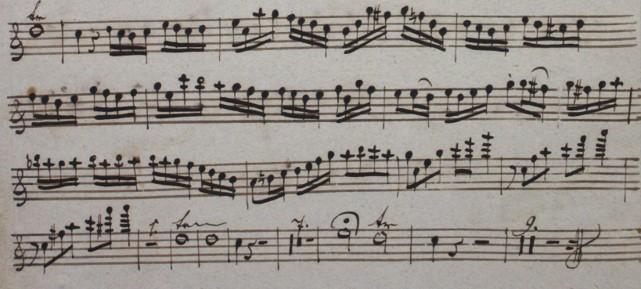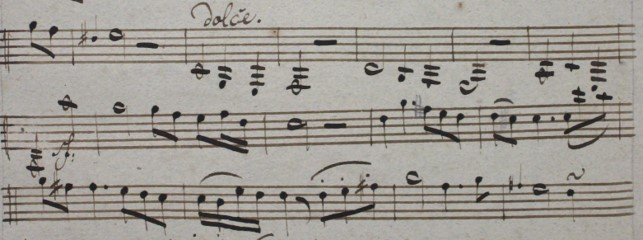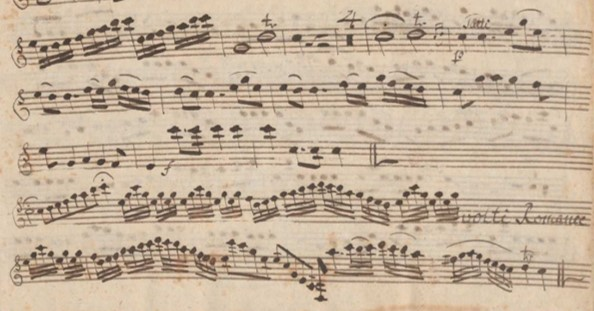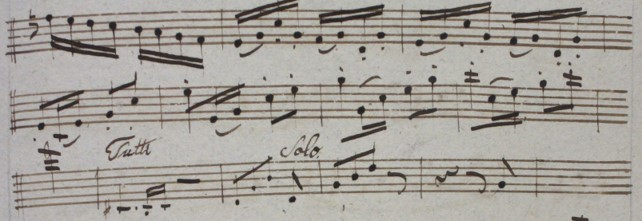Antonio Casimir Cartellieri clarinet’s solo works represent a mixture of
eighteenth-century writing traits. The wind virtuoso era experienced a great
transition of style and taste during its three decades. In a period from
approximately the death of Mozart to the death of Beethoven, the traveling
virtuoso lived through the drastic change of style. Cartellieri was one of
several composers for the clarinet during this transitional period who shaped
the direction of clarinet writing for the nineteenth century. Others affecting this
change include composers Crusell, Weber, Spohr, H. Baermann and for the
second half of the century Cavallini, Debussy, Saint-Sans and Brahms.
Range of tessitura
The eighteenth-century use of the clarinet severely limited the range
and tessitura1. The solo works of Stamitz, Yost, Lefevrè sum up the
eighteenth-century conception of stylized writing for the clarinet. These
works show tight confinement to the clarion register, dipping into the
chalumeau for technical passages like arpeggios or chordal function.
With regard to range and tessitura, the deservedly well-known Mozart
solo works, K. 581 and K. 622, are quite the exception to the normal
practice of that time. It is generally conceded that both, the quintet and
the concerto, were written for the basset horn and the basset clarinet,
instruments whose range extended downwards to written C in the bass
clef. Differently from Mozart and his contemporaries, that limited the
altissimo register on the G’’’, Cartellieri extended the Clarinet’s range
to the A’’’ as shown in Fig. 12 and 13.
Articulation assumed a top priority in the eighteenth century and is
comprehensively addressed in methods and treatises. Pages are devoted
to examples of how to articulate passages in a variety of ways- a
concern infrequently displayed in modern performance. A melody
sounded stylish to eighteenth-century ears only if the proper
articulations were used. It would not have been acceptable to play a
diatonic scale using the same tongue-stroke on all eight notes, but rather
by pairing the notes two-by-two or four-by-four by means of different
tongue-strokes.
Skilled and subtle use of different types of articulation was considered a
sign of a true artist. As Lefèvre wrote, “only the tongue can put
expression into melody and into the virtuosic passages. Without
tonguing, such passages would sound cold, thin and monotonous” 2.
The subject is elusive for us today since articulating on a clarinet with
the reed on top may be difficult to replicate, given that this way of
playing has disappeared. In his Essai of 1764, Valentin Roeser
recommends using the chest instead of the tongue to articulate, but this
is exceptional. Roeser says that clarinetists cannot play a rapid
succession of notes, which may suggest that clarinetists at this time
tended to slur extended passagework. Lefèvre recommends the syllable
“tu”, similar to other eighteenth-century treatises on wind instruments,
and disapproves of using the chest, stating that “those who play from
the chest get very tired and cannot play for long”3.
Printed signs for articulation also varied. Whereas most clarinet
methods simply refer to notes marked staccato as short, there was some
discrepancy in performing notes with dots and notes with dashes in
eighteenth-century sources. Leopold Mozart indicates that the dash
above a note makes it short but also somewhat heavier than a dot,
whereas Turk states the opposite.
Cartellieri in his clarinet works shows a preference for the older style of
the eighteenth-century, while Crusell, for example, displays traits of the
Romantic style (fig.17). Cartellieri doesn’t show diverse articulation
patterns within groups of sixteenth notes, adhering to a regularly
recurring pattern as shown in fig. 18-19-20.
Rapid scale passages in Cartellieri’s works are more often written with
each tone articulated. Variation of articulation was considered an
important expressive device, as Lefèvre makes clear: “if the
composer does not indicate the articulation of passages, the
intelligence of the artist should supply it. If a passage is repeated two
times, it must be played forte, and the piano, or first piano and then
forte, according to the character of the work. If finally, the passage is
repeated more than two times, one may make use of different
articulations to add nuance”4.
There were mostly two kinds of cadenzas in classical music: the
cadenza approached by the six-four chord at a full cadence (read
above); and the various connection or closing flourishes at half
cadences derived mostly from those used in baroque and pre-classical
music6. In Cartellieri's works, we have some examples of written-out
“cadential flourish”. In the first movement of the quartet No. 2 (fig. 23)
and in the Adagio of the Concerto No. 3 in E-flat Major (fig. 24), the
embellishment serves to lead into the recapitulation. In the concerto
No.4 (fig. 25), the flourishment leads into the new phrase of the
Rondo.
Cartellieri also accomplished an equalizing action balancing a wider
tessitura than was commonly employed in works of his time. The
lower tones of the clarion register serve as balance point by which the
pendulum can favour either direction: either upwards toward the
altissimo area, or downwards, toward the chalumeau register. This
effect not only a wider range but a wider tessitura, a new concept not
readily found in the literature in many of Cartellieri’s contemporaries.
The slow movements generally encompass a slightly smaller range
than do the other movements, regardless of genre. The tessitura in
these movements, however, is most confining, not unlike many works
of the period. Much less use of the notes below the clarion register
occurs in the second movements, perhaps indicating that in the late
eighteen century the tone quality of the chalumeau register is still not
considered aesthetically satisfactory for cantabile use (fig 14 -15). Low
notes are not as commonly used in the third movements as they are in
the first movements. The rich, mellow quality of tone in the depths of
the instrument’s compass is never emphasized as it is by Mozart in
the Larghetto of his Quintet K. 581 and in the rondo of his Concerto
K. 622 (fig. 16). This distinction in the concept of the value of the
chalumeau register is not to be attributed entirely to the recognized
gulf between the greater and lesser composer.
“A cadenza is a surprising discretionary embellishment appropriate to
the main passion of the piece or movement, on a note before the final
trill with fermata sign; or it is an artificial, decorative, surprising
lead-in appropriate to the main sentiment, from the note with the
fermata sign to the cadential trill"5.
Because classical woodwind cadenzas were usually invented by their
performers, few have survived in published form. Some cadenzas,
mostly written by the performers who played the pieces, are found in
eighteenth- and early nineteenth-century manuscripts or occasionally
in printed editions. An example can be found in the Concerto No.3 in
B-flat Major by Carl Stamitz (fig. 21).
.
Cartellieri in his clarinet solo works does not show himself to be fond
of elaborate cadenzas. Although in the quartets and concertos, there
are passages of cadenza character which are accompanied and placed
before the coda. The only cadenza approached by a six-four chord
is in his Double Concerto No. 1 in B-flat Major, as shown in figure 22.
Fig. 17 – B. H. Crusell. Clarinet quartet op 2, I mov. (a) bar n 66-68; (b) bar n 77-78; (c) bar n 80-83.


